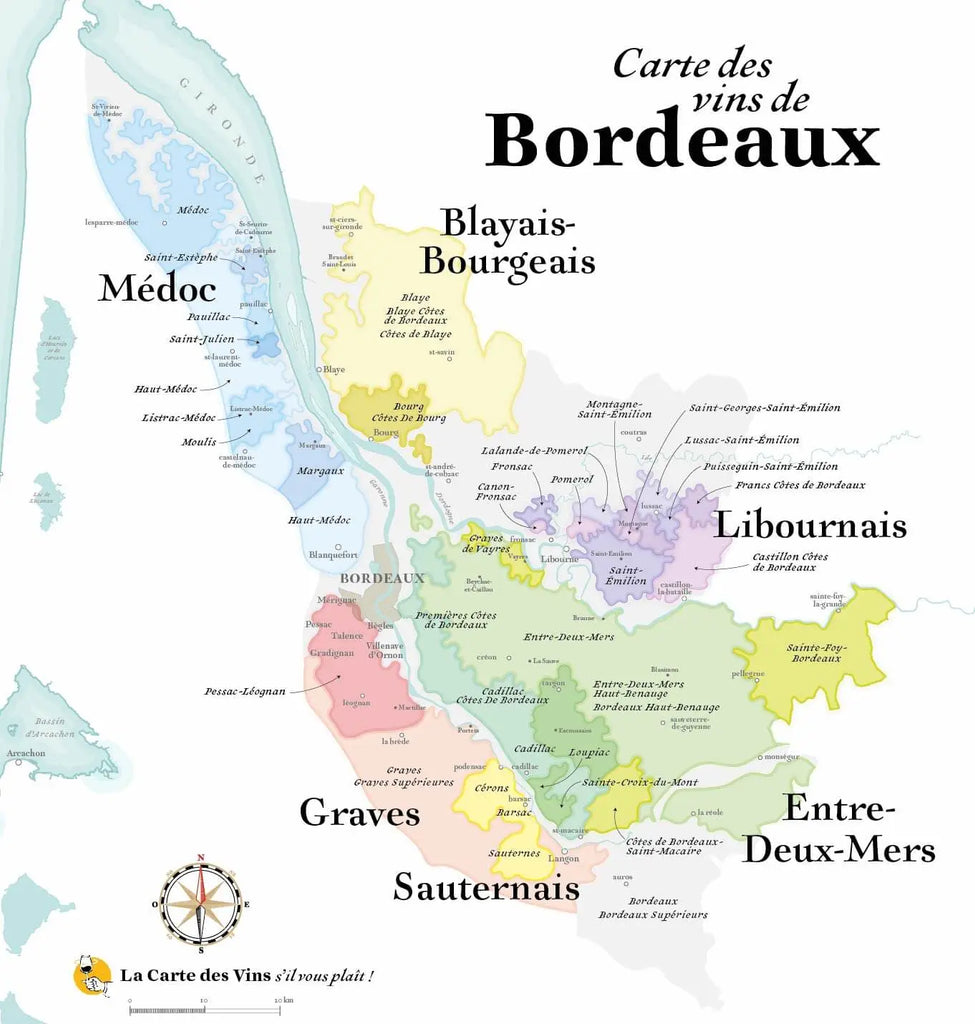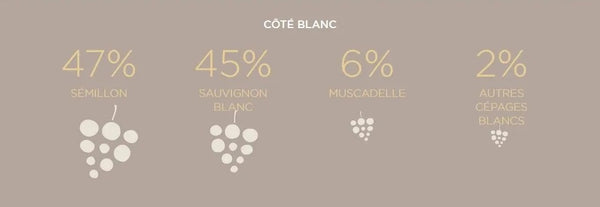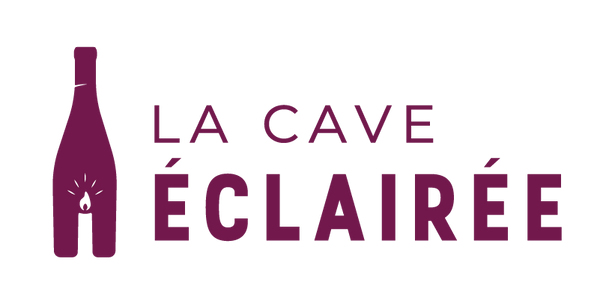Bordeaux is probably the region with the greatest wine reputation in the world (come on, along with Burgundy to be fair). And while the number of grape varieties, appellations and estates can sometimes be overwhelming, you'll see that it's not that complicated to navigate in Gironde!
In this article, we will dive into the heart of this iconic region to describe it to you simply, by exploring its 6 key grape varieties (3 white, 3 red) and its 3 sub-regions. We will take you on a journey through its renowned appellations and its Grands Crus Classés...but not only!
A wind of renewal is indeed blowing over the region for some time now, and some properties are moving away from so-called "traditional" wines with often marked oakiness to turn towards more festive and lighter cuvées, focused on pleasure and fruit.
Enjoy your discovery!

Bordeaux: 6 key grape varieties
Red wines
90% of the cuvées produced in Bordeaux are red wines. It is therefore naturally they who make the wine reputation of the region! Almost all of these are produced from three grape varieties:
- Merlot : it represents 2/3 of the production in red and offers rather supple tannins, a beautiful fruitiness (cherry, blackberry, blackcurrant) and gives a soft and charming texture to the wine.
- Cabernet Sauvignon : it is the second most present grape variety in Bordeaux. This one gives wines with powerful tannins, having a beautiful structure and offering fruity notes (blackcurrant, plum) and spicy notes (pepper).
- The Cabernet Franc : a kind of in-between of the two previous grape varieties, it can have an interesting tannic structure, but this will be less significant compared to that of the Cabernet Sauvignon. Its aromas are also fruity but also on the vegetal side (bell pepper, eucalyptus).

The characteristics of these three varieties being very complementary, they are regularly blended to produce the red wines of the region. However, it is entirely possible for local winemakers to produce single-varietal wines.
Other red grape varieties obviously exist in Bordeaux, such as Malbec or Petit Verdot. Nevertheless, these do not weigh much against the three giants.
White winess
Although in the minority, delicious white wines are also produced in the Bordeaux region! These can be dry or sweet and are made from the following three grape varieties:
- The Sémillon : representing nearly half of the white vineyard, it gives body to the wines and develops aromas of yellow fruits (mirabelle) as well as a hint of exoticism (pineapple, mango) on the palate.
- The Sauvignon blanc : it is the second white grape variety in the region and is almost as important in planted area as Sémillon.This one is very interesting for its natural acidity as well as for its expressive fruity aromas (citrus, white fruits, exotic fruits, etc.).
- The Muscadelle : a complementary variety to the previous two, it is generally found in small quantities in wines. Muscadelle is low in acidity and aromatically powerful. It offers floral and musky notes.

Just like with red wines, these 3 white grape varieties are very regularly blended to produce the final wines.
Bordeaux: 3 sub-regions
The Bordeaux vineyard is divided into 3 major areas :
- the right bank
- the left bank
- the Entre-deux-Mers
If you visualize Bordeaux, you indeed know that two rivers cross the region: The Dordogne in the north, as well as the Garonne in the south. Well, it is considered that the vineyards south of the Garonne are part of the left bank while those north of the Dordogne represent the right bank. Finally, the vines located between the two rivers are part of the Entre-deux-Mers.
Not clear enough? To find your way, feel free to take a look at the map towards the end of this article ! In the meantime, here are more details about these 3 exceptional wine regions with an oceanic climate.
The Right Bank
Located north of the Dordogne, the right bank primarily develops on clay-limestone soils and includes:
- The Libournais : an area renowned for its silky and complex red wines. Pomerol and Saint-Émilion have built the reputation of the local wines, but many other appellations exist here, such as Lalande-de-Pomerol, Canon-Fronsac or even Castillon-Côtes de Bordeaux.Merlot is generally the dominant grape variety in the blends.
- The Blayais-Bourgeais : vineyard of the AOC Côtes-de-Bourg and Blaye Côtes de Bordeaux. Less renowned, the latter still offer very interesting red wines with excellent value for money. Here too, the majority grape variety is Merlot.
The Left Bank
Located south of the Dordogne, the left bank mainly evolves on gravelly terroirs and includes:
- The Médoc : it is the most prestigious region of the Bordeaux vineyard, home to the Grands Crus Classés of 1855 and the great age-worthy wines. Prestigious appellations such as Margaux, Pauillac, Saint-Julien or even Saint-Estèphe are part of it.The predominant grape variety here is Cabernet Sauvignon, providing structure and power to the wines.
- Les Graves : located south of Bordeaux, this region produces red wines in the style of those from Médoc, meaning structured and rather powerful, but also remarkable dry white wines. The Pessac-Léognan appellation is the most renowned in the area and here too, Cabernet Sauvignon is the most planted grape variety.
- Le Sauternais : enclosed within the Graves, the Sauternais is dedicated to the production of delicious sweet wines, primarily made from Sémillon and Sauvignon Blanc. Sauternes is obviously the most renowned appellation in the area, but Barsac and Cérons should not be overlooked!
L'Entre deux mers
Nestled between the Dordogne and the Garonne, this vast geographical area produces 70% red wine and 30% white wine. However, be aware that, The Entre deux mers appellation (located in the region of the same name, are you following?) exclusively produces white wine over more than 1300 hectares. The key grape varieties of the latter are the famous Sémillon, Sauvignon, and Muscadelle.
The red wines of the region are produced under the Bordeaux and Bordeaux Supérieurappellations.
Other appellations are also present such as Cadillac, Loupiac or Sainte-Croix-du-Mont (sweet wines) as well as Cadillac-Côtes de Bordeaux (red wines) or even Graves de Vayres (red and sweet wines).

Conclusion
You are now fully prepared to explore the Bordeaux vineyard with more guidance! As you will have understood, the region offers magnificent prospects, regardless of your taste profile.
From fruity red wine to full-bodied red wine and delicious dry white wines as well as exceptional sweet wines ,the Bordeaux region is indeed full of gems just waiting for one thing: for you to discover them!
So, dive into this exceptional terroir, explore its iconic châteaux, and let yourself be carried away by the magic of Bordeaux wines. Cheers and do not hesitate to contact






























